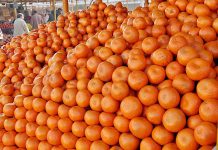There are moments in policymaking when the very tools meant to grow revenue end up stifling the source. The 20% Federal Excise Duty (FED) imposed on Pakistan’s formal packaged juice industry is a textbook example of such a miscalculation. Envisioned as a way to plug fiscal deficits, this additional levy—imposed on top of 18% GST—has not only throttled industry growth but also shrunk government revenues, devastated rural livelihoods, and handed a lifeline to the undocumented economy.
If ever a case needed re-examination ahead of Pakistan’s upcoming budget cycle, this is it.
Before the imposition of the 20% FED in Budget 2023–24, the formal juice industry was on a growth trajectory; projected to surpass PKR 72 billion in sales. But with the tax hike in place, those projections evaporated in thin air. Industry sales plunged by a staggering 45%, falling to approximately PKR 42 billion. The installed production capacity now sits idle. Factories are scaling back. And fresh investments—so critical for industrial vitality—have all but halted.
The most telling irony? The government’s revenue projections from this sector fell short. What was expected to be a net gain in tax receipts has instead become a net loss, as the higher tax rate triggered a dramatic contraction in taxable sales.
The damage isn’t confined to boardrooms or spreadsheets. It’s trickled down to Pakistan’s orchards, silos, and farms. A thriving juice industry means robust demand for mangoes, kinnows, peaches, and guavas—much of it procured directly from domestic farmers. In its prime, the formal juice industry purchased over 100,000 tonnes of fruit per annum.
Now, those volumes are in free fall. Consider mango procurement: just 20,233 tonnes were purchased last year, down from 31,000 tonnes in 2017–18. For fruit growers—many of whom rely on seasonal buyers like juice manufacturers—this represents not just lost income, but lost security. The formal juice sector was a steady buyer, often rescuing surplus produce from spoilage due to Pakistan’s high post-harvest fruit wastage. With formal players retreating, farmers are left exposed to volatile spot markets and collapsing margins.
The chain reaction is clear: fewer buyers, more spoilage, lower prices, weaker rural incomes.
For consumers, the excise hike has priced formal juices, long considered a convenient source of vitamins and hydration, out of reach. A 42% effective tax burden on a basic household item is neither equitable nor sustainable. Families are understandably shifting to cheaper alternatives. But what awaits them there?
The informal juice sector, now mushrooming in the vacuum left by formal players, is characterised by poor hygiene standards, little to no fruit content, and complete tax evasion. These products are cheaper, but they’re not safer, healthier, or regulated. The public health risks are substantial.
This isn’t just economic cannibalism—it’s a crisis of consumer protection. Ironically, while the formal industry complies with food safety laws and nutritional standards, it’s being punished by a tax structure that rewards opacity.
Make no mistake: the government’s attempt to raise revenue by taxing packaged juice more heavily has backfired. With volumes down 45%, the tax base has eroded. Informal sector players, who neither contribute to tax revenue nor abide by safety standards, have gained a greater market share.
In terms of pure revenue arithmetic, the juice tax has yielded diminishing returns. This is precisely the problem with narrow indirect taxation: it assumes inelastic demand. But as the juice case illustrates, consumer behaviour is highly elastic, especially in lower-middle-income economies like Pakistan’s. When prices rise due to taxation, demand shifts. Often, it shifts underground.
If the juice sector had remained at its projected PKR 72 billion level, a modest 10–12% tax could have generated far more sustainable revenue. But pushing the rate to 42% in total tax burden led to a collapse in both volume and tax intake.
Internationally, several countries have taken a progressive taxation approach to the beverage industry. Ireland, for instance, imposes a sugar-sweetened beverage tax but exempts 100% fruit juice and milk due to their nutritional value. The EU classifies natural fruit juices as essential dietary items and offers preferential tax treatment.
Why? Because these countries understand that not all beverages are created equal. Pakistan, in contrast, lumps together packaged juices with luxury or harmful goods under its excise regime: disincentivizing nutritious, locally-sourced products.
Juices and nectars are not just commercial products—they’re part of our food security matrix. They offer hydration, micronutrients, antioxidants, and convenience in a country where fruit wastage is rampant and diets are increasingly imbalanced.
The case for policy revision is unassailable. Here’s what a course correction could look like:
Reduce the FED from 20% to 15%, at minimum. This would restore a measure of affordability, boost volumes, and revive formal sector competitiveness.
Target the undocumented sector, not punish the documented one. Strengthen enforcement against untaxed, unregulated producers, who not only erode tax revenue but pose serious public health risks.
Reward food safety and compliance. Formal players who adhere to provincial food authority standards, invest in hygienic processing, and purchase from local farmers should be encouraged, not squeezed.
Use smart taxation. Differentiate between fruit-based and artificially flavoured drinks. Reward nutritional value, not sugar content alone.
Establish a public–private task force to reform juice industry taxation with representation from the Ministry of Finance, FBR, food authorities, and formal juice manufacturers.
Pakistan is at a critical juncture. It needs investment, not retrenchment. It needs revenue, but not at the cost of destroying productive, taxpaying industries. The formal juice sector offers a case study in how to balance fiscal needs with industrial, agricultural, and consumer realities.
We must ask ourselves: are we taxing productivity or promoting it? The juice excise debacle suggests we’re doing the former—and paying the price.
The upcoming fiscal year offers an opportunity to correct the course. Let’s not waste it.






















